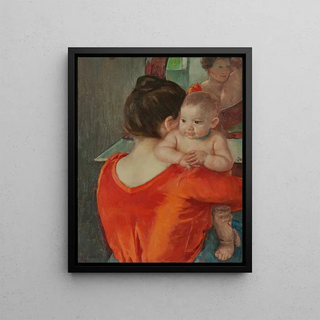Art print | Baby Charles looks over his mother's shoulder - Mary Cassatt


View from behind

Frame (optional)
Mary Cassatt's "Baby Charles looks over his mother's shoulder" is an open window into the intimacy of a mother and her child. This painting, both tender and evocative, captures a fleeting moment of everyday life, revealing the depth of family bonds. Cassatt, a prominent figure of the Impressionist movement, manages to capture the very essence of motherhood, blending emotion and technique with remarkable ease. Through this artwork, the artist invites us to feel the warmth and protection of a mother, while celebrating the beauty of the relationship between a mother and her son.
Style and uniqueness of the work
Mary Cassatt's style is distinguished by her ability to merge realism with a touch of Impressionism. In "Baby Charles looks over his mother's shoulder," the palette of soft colors and delicate brushstrokes create a soothing atmosphere. Light plays a crucial role, subtly illuminating the faces of the protagonists while casting shadows that add depth to the composition. Cassatt succeeds in conveying a sense of movement, as if the captured moment is about to continue. The position of the baby, turned towards his mother, evokes a feeling of curiosity and security, while the mother's gaze, both protective and attentive, emphasizes the tenderness of the moment. This artwork stands out for its ability to transcend a simple family portrait, becoming a true ode to motherhood.
The artist and her influence
Mary Cassatt, born in 1844, is one of the few women to have succeeded in establishing herself in the art world at a time when women were often excluded from artistic circles. Her friendship with figures such as Edgar Degas was instrumental in her artistic development, allowing her to explore themes close to her heart, notably the lives of women and children. Cassatt was able to bring a unique perspective to the Impressionist movement, focusing on intimate and personal subjects. Her influence extends well beyond her time, inspiring many contemporary and future artists to explore the

Matte finish

View from behind

Frame (optional)
Mary Cassatt's "Baby Charles looks over his mother's shoulder" is an open window into the intimacy of a mother and her child. This painting, both tender and evocative, captures a fleeting moment of everyday life, revealing the depth of family bonds. Cassatt, a prominent figure of the Impressionist movement, manages to capture the very essence of motherhood, blending emotion and technique with remarkable ease. Through this artwork, the artist invites us to feel the warmth and protection of a mother, while celebrating the beauty of the relationship between a mother and her son.
Style and uniqueness of the work
Mary Cassatt's style is distinguished by her ability to merge realism with a touch of Impressionism. In "Baby Charles looks over his mother's shoulder," the palette of soft colors and delicate brushstrokes create a soothing atmosphere. Light plays a crucial role, subtly illuminating the faces of the protagonists while casting shadows that add depth to the composition. Cassatt succeeds in conveying a sense of movement, as if the captured moment is about to continue. The position of the baby, turned towards his mother, evokes a feeling of curiosity and security, while the mother's gaze, both protective and attentive, emphasizes the tenderness of the moment. This artwork stands out for its ability to transcend a simple family portrait, becoming a true ode to motherhood.
The artist and her influence
Mary Cassatt, born in 1844, is one of the few women to have succeeded in establishing herself in the art world at a time when women were often excluded from artistic circles. Her friendship with figures such as Edgar Degas was instrumental in her artistic development, allowing her to explore themes close to her heart, notably the lives of women and children. Cassatt was able to bring a unique perspective to the Impressionist movement, focusing on intimate and personal subjects. Her influence extends well beyond her time, inspiring many contemporary and future artists to explore the






